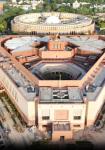Kanchi Shankaracharya Swami Jayendra Saraswati was candid in mooting his proposals before the All India Muslim Personal Law Board chief Maulana Rabe Hasan Nadwi, but there is no denying that he did change tack while trying to pave an amicable settlement for the centuries-old Ayodhya dispute.
Following his first meeting with AIMPLB chief Maulana Rabe Hasan Nadwi on June 7, when he called on the ailing cleric, the Kanchi seer wrote a letter on June 16 with a five-point proposal.
"Since the matter of mandir and masjid is currently under the judicial reference, we may have to wait (how long, I do not know). Therefore, we should try to work out a formula of compromise," the letter sent on the seer's behalf said.
He also urged the Maulana to hold a discussion at the board level on the following points:
1. Your board, on our request, may consider giving a no objection statement regarding construction of mandir upon the undisputed/acquired area.
2. Disputed area also can be discussed after sometime and an amicable settlement may be given to the court and verdict can be given by the court based on the settlement.
3. In order to protest the disputed area, a wall may be constructed separating it from the undisputed / acquired area.
4. If we reach a final negotiated settlement on the undisputed area, we shall both ensure support for the same from the various religious groups/sub-groups on each side to ensure that no further demands would be raised on the undisputed area.
5. Once we arrive at a cordial understanding, we may together approach the Government of India for its effective and time bound implementation.
Signed on behalf of the Shankaracharya by Kanchi Trustee N Sundaresan, the letter went on add, "His Holiness is sure under your benign leadership, the above suggestions would be supported and reciprocated. I am sure, this will lead the communities towards a peaceful coexistence and prosperity."
However, in reply to the clarifications sought by the Board chief on the question of abiding by the court verdict as also on the Board's 2002 resolution for reconstruction of the Babri Mosque at the exact site where it stood until December 6, 1992, the seer changed tack.
He sought to point out that in view of the Supreme Court's order to maintain status quo, the earlier suggested 'no objection certificate may not serve the desired purpose'.
"Under the circumstances, we offer the following explanation to our suggestion that the matter could be settled through mutual discussions:
1. The disputed area in Ayodhya is a place, which is highly revered by the Hindus. It is a historical fact that Babur the Great constructed a building at that place in commemoration of his victory. At present, due to some unavoidable reasons, there is no building in that place. The status quo position is that Rama is sitting over there. It is almost certain that the court judgment will not come early and when it comes, it will not be satisfying any community. In the present circumstances, if the judgment goes in favour of our community or even in favour of both the communities, we cannot expect communal harmony. Both sides are charged so much. Even though the disputed area may belong to the Wakf Board and is a place of faith to Muslims as well, since the place is of great faith and reverence to the Hindus, the Muslim community and Waqf Board may mentally think that they donate the area to Hindus.
2. Generally, if daily prayers are being offered in any mosque, asking for that place is not justifiable. In view of the fact that at present the area is without any building (empty) and an idol of Ram is placed there, it will not be right or possible to remove Rama from that place and construct a mosque over there in the interest of communal harmony. Local Muslims are already offering prayers in their mosques. That the idol of Rama is being worshipped, that the area is a disputed one and keeping in view the larger interests of the nation and communal harmony in particular, the Muslim community and the Wakq Board can decide to donate that area which is a place of matter of faith and belief to the Hindus of the country. By doing so and presenting it before the court we may be able to obtain a court judgement faster and earlier."
The letter went on to elaborate: "His Holiness Shankarachaya appeals that the disputed area be donated to the Hindus and acceding this request by the Muslim community will itself enhance the prestige of the Indian Muslims in the world. History will record that the Indian Muslims stood for communal harmony by this generous act of theirs and their name and fame will get a permanent place in history."
"Donation of the disputed area will only be the permanent solution," the letter added.
What, however provoked the Muslim Law Board bigwigs was the para relating to Mathura and Kashi on which too the Board chief had sought clarifications.
"A point was made that Kashi, Mathura and Ayodhya -- all three belong to the Hindus and keeping in mind the larger interest of the country and communal harmony. If not today, but at some time or other, these places have to be given to the Hindus. The Muslims have to mentally prepare themselves for this."
The Muslim Law Board leaders took affront to these concluding observations, which they felt, amounted to a 'veiled threat'.





